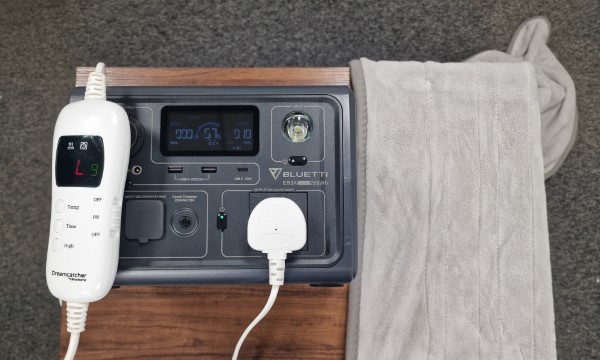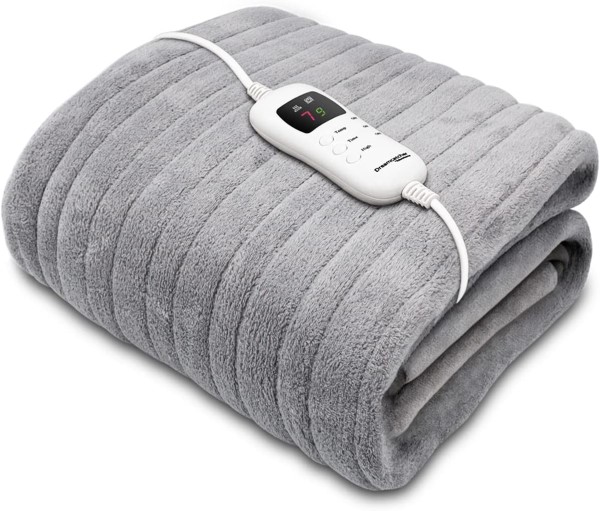With a wide variety of portable power stations offered by Bluetti, you might wonder which can power an electric blanket.
All Bluetti portable power stations can run an electric blanket. However, the run time will depend on the battery capacity and the required output to power the electric blanket. The smallest Bluetti EB3A will run a standard-size electric blanket for 1 hour 45 minutes, while the AC200MAX will last over 15 hours.
Electric blankets can be great around the house, in a cold office or camping. But which Bluetti is best for your electric blanket, and how long will they last? Let's take a look.

Table of contents
Different electric blankets have different power requirements; however, most will range between 100w and 140w per hour. Various models of Bluetti have varying capacities, so let's look at how long each will power an average 120w electric blanket.
120w Electric Blanket
| Model |
120w electric blanket Runtime |
| EB3A | 1 hours, 45 minutes |
| EB55 | 3 hours, 54 minutes |
| EB70 | 4 hours, 50 minutes |
| AC60 | 2 hours, 51 minutes |
| AC180 | 8 hours, 04 minutes |
| AC200P | 14 hours, 40 minutes |
| AC200MAX | 15 hours, 01 minutes |
The above is based on estimated power consumption when the electric blanket is set to its highest heat and continuously uses the maximum output required. If you use it at lower temperatures or with timers, the electric blanket will last longer, as less power is needed.
I can comfortably get more than 10 hours out of my EB3A on lower temperature settings!
How do you calculate how long your electric blanket will run?
To calculate how long your electric blanket will run, you will need the following:
- The battery capacity of the power station,
- the power consumption of the electric blanket, and,
- the power station efficiency.
To help, I built a simple calculator for each model of Bluetti.
Alternatively, you can use the following calculation to determine how long your electric blanket will run for any portable power station.
Run-time calculation
Battery capacity (watt-hours) / Electric blanket power (watts) * Power Station efficiency (%) = run-time (hours)
Electric blanket power consumption
Your electric blanket will likely have a label indicating its power consumption. However, if there isn't, you can also find the power consumption in the user manual, which you can often download online if you have no longer got yours to hand.
Remember, your overall power consumption will vary if you have various settings, which most electric blankets do. As the heat increases, so will the power required.
Most electric blankets will state their wattage based on the maximum required output.
Bluetti power station efficiency
Different Bluetti's will have varying efficiencies, and there will be a difference between AC and DC powering.
But, most electric blankets will need to be powered by AC, so let's look at the AC inverter efficiencies by each model:
| Model |
AC Inverter Efficiency |
| EB3A | 78% |
| EB55 | 87% |
| EB70 | 81% |
| AC60 | 85% |
| AC180 | 84% |
| AC200P | 88% |
| AC200MAX | 88% |
Bluetti EB3A electric blanket runtime
For my electric blanket, there are many settings. Here is a breakdown of the power required to power each for one hour.
| Heat setting |
Watts |
| (Low) |
18w |
| 2 |
31w |
| 3 |
44w |
| 4 |
56w |
| 5 |
69w |
| 6 |
83w |
| 7 |
94w |
| 8 |
107w |
| 9 (High) |
117w |
As you will notice, even on the highest heat, it doesn't use the 120 watts in the hour that it states on its label. Instead, it only uses 117.
So why is this?
Electric blankets have a heating element. Typically, the heating element will either be "on" or "off". Therefore, even on the lowest heat, the wattage will spike up to its maximum stated output and quickly reduce to its minimum power.
However, while on the highest heat, the maximum output will last for longer as the heating element is turned on for longer. This, in turn, uses more power.
When estimating how long your Bluetti will power an electric blanket, consider what heat setting you will use.
Straight out of the box, your Bluetti should be configured to run A/C appliances, including an electric blanket.
But, before using your Bluetti to power your electric blanket, you should first charge its internal battery.
Your user guide will explain how to charge your specific power station. You can find a digital copy of your user guide on the Bluetti website here.
In general, one of the easiest ways to charge your Bluetti will be using the included power cable in a wall outlet tied to the grid.
Once your power station is charged, you can plug your electric blanket straight into the A/C outlet on the Bluetti.
Even the smallest Bluetti EB3A is capable of powering an electric blanket. However, you might find the battery lacking, so we recommend the Bluetti EB55 as the best portable power station for an electric blanket.
Bliuetti EB55
We recommend the EB55 when choosing a Bluetti to run an electric blanket.
During the cold winter days, I want my electric blanket to last for several hours during the day, which the EB55 can comfortably do with most electric blankets set to the highest heat.
Boasting a 700W output and a 537WH battery, it can run a 120w electric blanket on full power for nearly 4 hours and on lower power settings for nearly a full day!

But how does the Bluetti stack up with its competition?
Bluetti makes some fantastic portable power stations, all of which are more than capable of running an electric blanket. However, you may consider cheaper alternatives or other brands which offer more features for your money.
We have tested models from the leading portable power station brands, Bluetti, Ecoflow, and Jackery.
| Portable Power Station |
Inverter Power |
Battery Size |
| Bluetti EB55 |
700 watts |
537 Wh |
| EcoFlow RIVER 2 Max |
500 watts |
512 Wh |
| Jackery 500 |
500 watts |
518 Wh |
Based on its inverter output, battery capacity, build quality and price, the Bluetti EB55 is the best in its class.
However, if you were not looking at running other more power-hungry appliances, I would also strongly consider the Ecoflow RIVER 2 Max; especially if it were on sale cheaper than the Bluetti EB55.
You will often find Bluetti and Ecoflow products on sale. Check out their latest prices below:
Bluetti EB55 Latest Price
EcoFlow RIVER 2 Max Latest Price
Jackery 500 Latest Price
A great feature of a Bluetti is that you can charge your battery while powering an electric blanket. You can use your mains power at home to keep your Bluetti fully charged while using your electric blanket.
This can be a great option to use your Bluetti as a UPS to keep your electric blanket running during a power outage.
But what if you are on the road or don't have access to mains power?
Two other great ways to keep your power station charged are:
Solar power
Bluetti works excellently with solar panels. Whether you have yours hard mounted on the roof of your house or portable for camping, using the sun's rays to charge your battery is a great way to boost performance.
Your power station will include a solar charge cable pre-terminated to MC4, a widespread solar connector.
While Bluetti sells solar panels specifically for their power stations, they can be expensive compared to others on the market.
Bluetti PV200 Solar Panel
The PV200 Solar Panel is compatible with all their portable power stations and provides 200W of solar power. However, they cost more than double what you can pay for a similar-performing panel from other manufacturers.

But, if you use your own solar panels, be careful; you must ensure that they are within the specification of your Bluetti.
Important!
Ensure you refer to the owner's guide, which will tell you the Open Current Voltage (OCV), maximum input current, and maximum input power.
Do not exceed these parameters, or you will damage your power station!
DC power
Charging your portable power station with DC power is one of my favourite ways to extend its runtime.
Bluetti offers pass-through charging, meaning you can charge your power station while simultaneously powering an electric blanket.
So, even if you own their baby EB3A, you can get hours of extra runtime by charging with DC.
You can charge your Bluetti with:
- Cigarette Lighter Port (12V/24V) or,
- Solar (8A max, 200W max) DC
Powering by another DC battery is one of my favourite ways to add extra battery capacity cheaply!
My setup allows me to more than double my battery capacity for much less than buying the next model up.
This allows me to charge my Bluetti EB3A at 152w, which is more than enough to extend the battery on the EB3A while powering an electric blanket.
Even better, I get to use the EB3A's improved screen to see exactly what percentage of the battery remains (the EB55 lacks this). Plus, I can use it for other projects too!
To replicate, you will need the following:

Most energy-efficient electric blanket
Finding an energy-efficient electric blanket could save up to 75% on its annual energy consumption. This means less money every month for your bills, as well as it being more green for our planet.
Dreamcatcher Electric Heated Throw Blanket
We suggest the best energy-efficient electric blanket is the Dreamcatcher Electric Heated Throw by Futura Home
This is the one I have, and I have used it for over a year with no issues. There are nine temperature settings, along with a 1-9 hour timer that allows you to stay warm in an energy-efficient way.

It is rated at 120 watts, but at lower temperatures, it uses minimal power and can last for over 11 hours, even with the smallest Bluetti EB3A!
It is also lightweight and warm on its own, with little or no power, making it ideal for camping with a portable power station.
I also feel safe knowing that once the timer is set, I can sleep without worry of fire or burns.
While powering your electric blanket off-grid with a portable power station is a great solution, it will only be suitable for some.
Some other alternative ways to power your electric blanket include:
- solar
- diesel generator
- gas (propane) generator
- buy an electric blanket which has a battery built-in (or can be plugged into a power bank)
- UPS
To stay as green as possible, we always recommend, where possible, powering your devices using solar power.
About the author
Andy Vickery has been DIY'ing energy projects for years. From solar and home electrics, to car rewires, Andy is passionate about sharing his personal experiences.